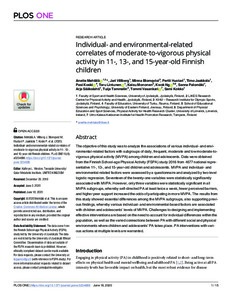Individual- and environmental-related correlates of moderate-to-vigorous physical activity in 11-, 13-, and 15-year-old Finnish children
Timo Jaakkola; Kwok Ng; Sanna Palomäki; Arja Sääkslahti; Tuija Tammelin; Anette Mehtälä; Pertti Huotari; Kaisu Mononen; Pasi Koski; Minna Blomqvist; Sami Kokko; Jari Villberg; Taru Lintunen; Tommi Vasankari
Individual- and environmental-related correlates of moderate-to-vigorous physical activity in 11-, 13-, and 15-year-old Finnish children
Timo Jaakkola
Kwok Ng
Sanna Palomäki
Arja Sääkslahti
Tuija Tammelin
Anette Mehtälä
Pertti Huotari
Kaisu Mononen
Pasi Koski
Minna Blomqvist
Sami Kokko
Jari Villberg
Taru Lintunen
Tommi Vasankari
PUBLIC LIBRARY SCIENCE
Julkaisun pysyvä osoite on:
https://urn.fi/URN:NBN:fi-fe2021042823393
https://urn.fi/URN:NBN:fi-fe2021042823393
Tiivistelmä
The objective of this study was to analyze the associations of various individual- and environmental-related factors with subgroups of daily, frequent, moderate and low moderate-to-vigorous physical activity (MVPA) among children and adolescents. Data were obtained from the Finnish School-age Physical Activity (FSPA) study 2016 from 4677 national representative 11-, 13-, and 15-year-old children and adolescents. MVPA and individual- and environmental-related factors were assessed by a questionnaire and analyzed by two-level logistic regression. Seventeen of the twenty-one variables were statistically significantly associated with MVPA. However, only three variables were statistically significant in all MVPA subgroups, whereby self-directed PA at least twice a week, fewer perceived barriers, and higher peer support increased the odds of participating in more MVPA. The results from this study showed essential differences among the MVPA subgroups, also supporting previous findings, whereby various individual- and environmental-based factors are associated with children and adolescents' levels of MVPA. Challenges to designing and implementing effective interventions are based on the need to account for individual differences within the population, as well as the varied connections between PA with different social and physical environments where children and adolescents' PA takes place. PA interventions with various actions at multiple levels are warranted.
Kokoelmat
- Rinnakkaistallenteet [19207]
